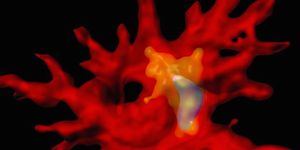Some mushrooms glow, which may come as news to you, but not so to Aristotle, who lived some 2,400 years ago.
He's on record asking why this is so.

And for those who continue to ask, we now have an answer: light given off by the fungi entices insects such as beetles, flies, wasps, and ants, whose role in a reciprocal dance is to spread the fungal spores around.
A circadian clock helps regulate the cycles of bioluminescence, a discovery that clued researchers in to the prospect of the light show serving a purpose. "Regulation implies an adaptive function for bioluminescence," says Jay Dunlap, PhD, department chair, professor of genetics and biochemistry, Geisel School of Medicine, Dartmouth.
"It appears that fungi make light so they are noticed by insects who can help the fungus colonize new habitats," says Cassius Stevani, PhD, associate professor, Department of Fundamental Chemistry, Instituto de Química-Universidade de São Paulo, Brazil. The circadian control of bioluminescence makes the process more efficient.
Lots of living things emit light, but in this regard, fungi fall into the categories of rare and little known. Of the 100,000-plus described fungi species, a mere 71 give off greenish light in a biochemical process that involves a cocktail of oxygen and energy. Before this discovery, researchers held that, generally, fungi emit light 24/7, perhaps as a byproduct of metabolism.
Dunlap and Stevani, who helmed the research, found that this is not that case for Neonothopanus gardneri, one of the largest and most brilliant of glowing mushrooms. This species is also known by local Brazilians as "flor de coco" (coconut flower) as it adheres to leaves at the base of juvenile palm trees in coconut forests.
N. gardneri's radiance is timed by a temperature-compensated circadian clock, conserving the all-important energy expenditure for when it would be clearly visible, the researchers suggest.
Creating a troop of sticky, fake mushrooms from acrylic resin, with only some illuminated from within by green LED lights, the researchers sought to test out the aim of the glow. The impostors were dotted on the forest floor, where the real fungi reside. Those that glowed bright drew greater numbers of staphilinid rove beetles, flies, wasps, ants, and "true bugs," than those that did not.
The researchers want to detect the genes that are responsible for the fungi's glow, and better understand their relationship with the circadian clock that controls them. Infrared cameras have been used to more closely observe the interplay between N. gardneri mushrooms and arthropods, especially bigger ones.
The mushrooms are teaching us something about the bigger picture, too.
"Without them, cellulose would be stuck in its form, which would impact the whole carbon cycle on Earth," Stevani says. "I dare to say that life on Earth depends on organisms like these."
Other fungi in the group known as basidiomycetes, including two bioluminescent mushrooms, are also parasites of coffee and pine trees. "It is very important to know how basidiomycetes grow and consequently how they spread their spores," Stevani says.
The new study, "Circadian Control Sheds Light on Fungal Bioluminescence," is in the Cell Press journal Current Biology.









